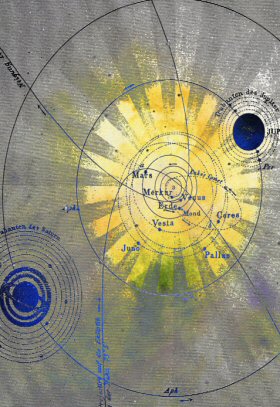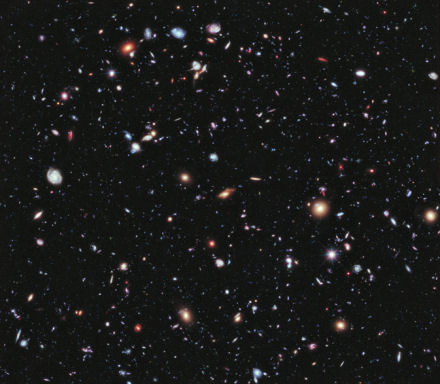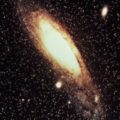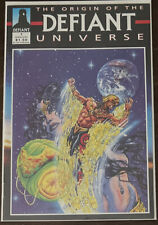
Using Loop Quantum Gravity theory, physicists have proposed a new mathematical model of what the universe looked like before the Big Bang. Writing in Nature Physics, Martin Bojowald, assistant professor of physics at Penn State, explains how the work can be used to derive new details about the properties of a quantum state as it travels through the Big Bounce, a concept which Bojowald contends can replace the classical idea of a Big Bang as the beginning of the universe. The research also suggests that, although it is possible to learn about many properties of the earlier universe, we always will be uncertain about some of these properties because his calculations reveal a “cosmic forgetfulness” that results from the extreme quantum forces during the Big Bounce.
As described by Einstein’s Theory of General Relativity, the origin of the Big Bang is a mathematically nonsensical state – a “singularity” of zero volume that nevertheless contained infinite density and infinitely large energy. But by using Loop Quantum Gravity, which combines Einstein’s Theory of General Relativity with equations of quantum physics, Bojowald and his co-theorists have come up with what they believe is the first mathematical description to systematically establish the existence of the Big Bounce and to deduce properties of the earlier universe from which our own may have sprung.
Quantum-gravity theory indicates that the fabric of space-time has an “atomic” geometry that is “woven” with one-dimensional quantum threads. This fabric tears violently under the extreme conditions dominated by quantum physics near the Big Bounce, causing gravity to become strongly repulsive so that, instead of vanishing into infinity as predicted by Einstein’s Theory of General Relativity, the universe rebounded in the Big Bounce that gave birth to our expanding universe. The theory reveals a contracting universe before the Big Bounce, with space-time geometry that otherwise was similar to that of our universe today.
Bojowald found he had to create a new mathematical model to use with the theory of Loop Quantum Gravity in order to explore the universe before the Big Bounce with more precision. “A more precise model was needed within Loop Quantum Gravity than the existing numerical methods, which require successive approximations of the solutions and yield results that are not as general and complete as one would like,” Bojowald explained. He developed a mathematical model that produces precise analytical solutions based on a set of mathematical equations.
In addition to being more precise, Bojowald’s new model also is much shorter. He reformulated the quantum-gravity models using a different mathematical description, which he says made it possible to solve the equations explicitly and also turned out to be a strong simplification. “The earlier numerical model looked much more complicated, but its solutions looked very clean, which was a clue that such a mathematical simplification might exist,” he explained. Bojowald reformulated quantum gravity’s differential equations – which require many calculations of numerous consecutive small changes in time – into an integrable system, in which a cumulative length of time can be specified for adding up all the small incremental changes.
The model’s equations require parameters that describe the state of our current universe accurately so that the universe can be “un-evolved” to reveal its state at earlier times. The model’s equations also contain some “free” parameters that are not yet known precisely but are nevertheless necessary to describe certain properties. The two free parameters, which Bojowald found were complementary, represent the quantum uncertainty in the total volume of the universe before and after the Big Bang. “These uncertainties are additional parameters that apply when you put a system into a quantum context such as a theory of quantum gravity,” Bojowald said. “It is similar to the uncertainty relations in quantum physics, where there is complimentarity between the position of an object and its velocity – if you measure one you cannot simultaneously measure the other.”
Similarly, Bojowald’s study indicates that there is complementarity between the uncertainty factors for the volume of the universe before the Big Bounce and the universe after the Big Bounce. “For all practical purposes, the precise uncertainty factor for the volume of the previous universe never will be determined by a procedure of calculating backwards from conditions in our present universe, even with most accurate measurements we ever will be able to make,” Bojowald said. This discovery implies further limitations for discovering whether the matter in the universe before the Big Bang was dominated more strongly by quantum or classical properties.
“A problem with the earlier numerical model is you don’t see so clearly what the free parameters really are and what their influence is,” Bojowald said. “This mathematical model gives you an improved expression that contains all the free parameters and you can immediately see the influence of each one,” he explained. “After the equations were solved, it was rather immediate to reach conclusions from the results.”
Interestingly, Bojowald’s model shows that at least one of the parameters of the previous universe did not survive its trip through the Big Bounce – that successive universes likely will not be perfect replicas of each other. “The eternal recurrence of absolutely identical universes would seem to be prevented by the apparent existence of an intrinsic cosmic forgetfulness,” he concluded.
Related articles:
The Universe As Magic Roundabout
Big Bang Brouhaha Brewing
Infinite Entropy Mooted As Universal Panacea
Physicists Hope For Glimpse Of Extra Dimensions

















Comments are closed.